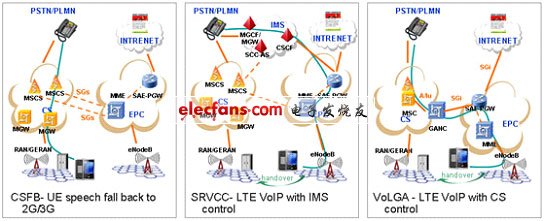With the rapid development of personal voice services, wireless data networks have also moved from GPRS/HSPA to LTE . LTE will give us a high-bandwidth wireless access network to better support a variety of mobile applications, but it also hides the crisis, the biggest crisis comes from VOIP.
LTE's IMS-based all-IP architecture enables packet-domain-based voice and multimedia service development. IMS adopts the SIP protocol as the unified session control protocol for different packet access networks, thus becoming the industry-recognized platform for next-generation voice/multimedia service control and network convergence. The emergence and gradual maturity of LTE technology has made commercial deployment of VoIP services for mobile network E2E possible. The high bandwidth, high mobility, and low latency of the LTE technology ensure that the user's call service experience on the LTE network can be the same as that of the conventional CS. The implementation of LTE VoIP marks an important step for the mobile network to the All-IP network. The PS domain will eventually replace the mobile CS domain and become a true All-IP network.
Due to the initial investment restrictions of operators, LTE will be deployed in a hotspot area and then gradually spread out. Therefore, in order to meet the voice service requirements of users anytime and anywhere, LTE voice service solutions still depend on GERAN/UTRAN for a long time. CS access coordination. The LTE voice service should have no change requirements for the GERAN/UTRAN wireless network, and the mobile circuit domain core network should be modified as little as possible to facilitate the operator's LTE deployment.
Handover requirements for LTE and UTRAN/GERAN
In order to simplify the interoperability requirements of LTE and UTRAN/GERAN, reduce the complexity of LTE terminal radio modules, and extend the standby time of LTE terminals, the 3GPP industry decided to adopt Single Radio technology between LTE and UTRAN/GERAN. Single Radio means that LTE terminals cannot simultaneously perform services on LTE and UTRAN/GERAN, which brings new demands for handover control between LTE and UTRAN/GERAN.
With the joint efforts of the 3GPP industry, circuit domain voice (CSFB) fallback to 2G and 3G is seen as a step in the evolution from circuit-switched networks to all-IP. When making or receiving a voice call, the CSFB solution can switch user equipment (UE) access from LTE to 2G/3G.
In order to promote the industry to support the 3GPP standard, Ericsson and several other vendors and operators jointly launched the "One Voice" program. The main goal of the program is to develop a baseline profile that terminals and network vendors should follow to ensure interoperability. Since its adoption by the GSM Association in early 2010, the program has gained wider acceptance in the industry.
The benchmark specification for the One Voice initiative forms the basis of the IMS specification for voice and short messages (GSM Association Permanent Reference Document IR.92), commonly referred to as VoLTE (LTE Voice).
The requirements in the benchmark specification cover each layer of the network. Each layer also contains IMS features, media requirements, bearer management features, LTE wireless requirements, and general functionality. These requirements are in accordance with 3GPP Release 8 (Rel-8), and others are required from 3GPP Release 9 (Rel-9) to support packet switched emergency calls.
LTE VoIP and multimedia services are the inevitable trend of mobile network evolution. The CSFB solution supporting UE switching from LTE to 2G/3G will eventually become a transition technology for CS domain voice to all IP domain voice.
Industry LTE voice service implementation architecture
Currently, there are three implementation architectures for LTE voice services in the industry:
1.CSFB(Circuit Switched Fallback in Evolved Packet System)
2.SR-VCC (Single radio voice conTInuity control)
3.VoLGA (Voice over LTE via Generic Access technology)
The first two have been written into the 3GPP R8 specification to be frozen, and the latter is closely discussed in the VoLGA organization.

Figure 1 Three LTE voice service implementation architectures in the industry
Best advertising player or money making machine---Led Kiosk Xposter
This Type of indoor led Xposter also called led AD player is one of new applications for led displays. Developed from led screens, it is more suitable and friendly to operate.
Function of Xposter is as following:
Ultra slim& light weight. Installation friendly
Xposter has been engineered with latest technologies to give smoother, slimmer profile. It's crafted in beautiful anodized light weight& duralble aluminum body to make entire poster framce less than 35KGS. More portable and easier to install.
Plug and Play Media player. No Configuration.
Update your digital content in the powerfull built in media play via wifi or USB. Easy to follow on screen menu makes it absolutely simple to schedule your content and complicated configuration needed.
Front Serviceable
You'll love the speedy convenience of doing servicing of panel module replacement from front with just a magnet tool.
Easy Controll & operation
High refresh rate and 128 steps of gradation controll. No Pc required, Thus saves on cost, increases reliability and makes operations simpler.
Intelligent Management.
Xposter is pre-integrated software enables you to connect it with a PC or Android devices from a single location via rj45, wifi,3G, USD and HDMI. That makes it extremely easy to identify your display and manage settings.
Indoor Led Kiosk Eposter,Indoor Led Advertising Player,P2.5 Indoor Led Ad. Poster,Intelligent Indoor Led Advertising Player
Shenzhen Priva Tech Co., Ltd. , https://www.privaled.com